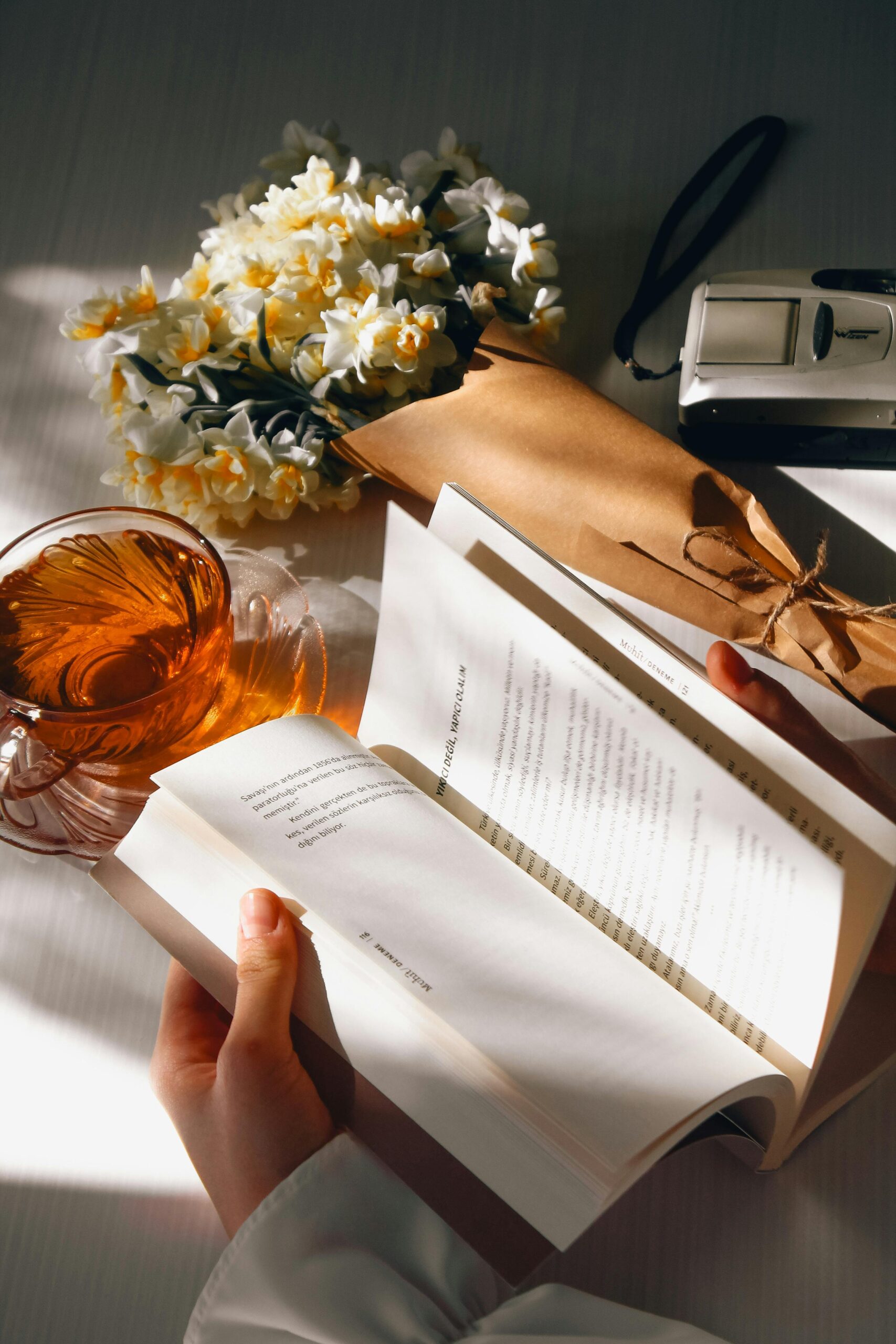
Bookish life, one chapter at a time
I’m so glad you found your way here. My name is Pipper, and I created A Passion for Books as a cozy space for readers like you and me—a place where stories come to life beyond the page, and our shared love of books can thrive. Whether you’re a lifelong bibliophile or someone just getting back into reading, you’re right at home here.
Over the years, my relationship with reading has only deepened. I’ve built my own little home library—complete with mismatched bookshelves, handmade bookmarks tucked in every other novel, and a reading nook that always has a cup of tea nearby.
Rediscover the joy of reading,
one post at a time
- The Timeless Allure of Classic Literatureby PiperClassic literature holds a unique place in the hearts of readers worldwide. These enduring works offer more than just a glimpse into the past; they provide timeless insights, rich storytelling, and characters that continue to resonate with readers of all ages. But what exactly is it about classic literature that keeps it alive in our modern world? ## The Definition of a Classic Before diving into why classic literature remains significant, it’s essential to understand what qualifies a book as a “classic.” Generally, classics are works that have stood the test of time, often covering universal themes such as love, loss, ambition, and morality. These stories are typically characterized by: – **Enduring themes**: Addressing universal human experiences. – **Cultural significance**: Offering insights into the period in which they were written. – **Literary merit**: Showcasing exceptional writing and storytelling. Notable examples include *Pride and Prejudice* by Jane Austen, *Moby Dick* by Herman Melville, and *Crime and Punishment* by Fyodor Dostoevsky. ## Why We Still Read Classics Today ### 1. **Timeless Themes** One of the main reasons classic literature remains relevant is its exploration of timeless themes. Books like *To Kill a Mockingbird* by Harper Lee delve into issues of racial injustice and moral growth, themes that continue to resonate with readers in today’s society. These stories allow us to explore complex human emotions and societal issues from different perspectives. ### 2. **Cultural and Historical Insights** Classic literature offers a window into the past, providing valuable insights into the culture, norms, and values of different eras. By reading Charles Dickens’ *A Tale of Two Cities*, for instance, we gain a better understanding of the socio-political climate of the French Revolution. These works help us appreciate how much has changed—and sometimes, how much remains the same. ### 3. **Complex Characters** The characters found in classic literature are often multifaceted and undergo significant development throughout their stories. Consider the tragic hero of *Hamlet* by William Shakespeare, whose internal struggles and philosophical musings captivate audiences even today. These complex characters invite readers to reflect on their own lives and the human condition. ### 4. **Literary Techniques** Classic literature is a treasure trove of literary techniques and styles that continue to influence modern writing. From the stream of consciousness technique used by James Joyce in *Ulysses* to the intricate symbolism in Nathaniel Hawthorne’s *The Scarlet Letter*, these works are studied for their innovative approaches to storytelling. ## How to Appreciate Classic Literature For those new to classic literature, it can sometimes be daunting to dive into these dense texts. Here are a few tips to enhance your reading experience: – **Start with recommendations**: Begin with well-loved classics that are known for their engaging narratives, such as *The Great Gatsby* by F. Scott Fitzgerald or *Jane Eyre* by Charlotte Brontë. – **Join a book club**: Discussing classics with others can provide new insights and make the reading experience more enjoyable. – **Read with context**: Understanding the historical and cultural background of a book can enrich your appreciation of its themes and characters. – **Take your time**: Classic literature often requires a slower, more thoughtful approach to fully grasp its depth and nuances. ## Conclusion Classic literature continues to captivate readers because of its powerful storytelling, rich thematic content, and ability to connect with the human experience across generations. Whether you’re a seasoned reader or just beginning your journey into the world of classics, these works offer endless opportunities for reflection and discussion. Embrace the timeless allure of classic literature, and discover the treasures that await within their pages. Happy reading!
- When My AC Blew Hot Air in Cooper City – These Guys Saved the Dayby Piper
Living in Cooper City, you know how brutal it gets when your AC decides to quit on you—especially when it starts blowing hot air instead of cool relief. That’s exactly what happened to me one sweaty Saturday afternoon. I’d been noticing my house felt a little warmer than usual, but I figured it was just the South Florida heat doing its thing. That is, until I walked past the vent and felt hot air pumping into the room. Not warm. Not lukewarm. Hot.
I panicked a little. I started Googling “AC blowing hot air Cooper City” and hoped someone—anyone—was available to come out. I expected the usual weekend runaround: “We can’t get to you until Monday,” or worse, “Sure, but it’s a $200 weekend emergency fee.”
But then I found this highly-rated local HVAC company (and yes, I double-checked the reviews because I wasn’t about to get scammed). Their website looked professional, and the reviews mentioned how friendly they were and that they didn’t charge hidden fees. I figured it was worth a shot.
I gave them a call, not expecting much. But to my surprise, someone answered right away—and they were incredibly nice. No automated system, no long wait. I told them what was happening, and they said they could send a technician out that afternoon, even though it was Saturday. I braced myself for the fee conversation, but they reassured me there would be no extra charges for the weekend visit. That alone was enough to make me breathe a little easier.
Less than two hours later, a technician was at my door. He was friendly, professional, and actually seemed happy to be helping. That’s something I don’t see a lot anymore. He got right to work, checking the system, explaining what he was doing as he went, and answering every one of my questions without any attitude or pressure.
Turns out, the issue wasn’t anything huge—thankfully. Something in the system had failed, but it was a quick repair. He had the part on hand and got it fixed on the spot. No sales pitch. No upsell. No “you need a whole new unit” speech. Just straightforward, honest work.
And when I asked how much the visit would cost, I braced myself again. But sure enough, the bill was just for the repair. No hidden service fee. No “Saturday premium.” Just one fair, reasonable price.
Even better? Before he left, the tech took the time to show me a few simple, cost-effective ways to keep my AC running better and save money on my energy bill. He walked me through how often to change the filter (something I had definitely been slacking on), showed me how to rinse the coils from the outside unit, and even gave me tips on setting my thermostat more efficiently. It was like a mini-AC workshop, and I learned a ton in just a few minutes.
It’s not every day you find a service company that actually cares—not just about the job, but about helping you as a homeowner. That’s why I’m looking forward to using them again, and probably even signing up for one of their maintenance plans. It’s clear they’re not just out to make a quick buck. They’re building trust, one visit at a time.
If you’re in Cooper City and your AC starts acting up—especially if it’s blowing hot air—I can’t recommend these guys enough. They saved my weekend, cooled my house, and treated me with genuine respect. And in this Florida heat, that kind of service is pure gold.
- How to Start or Run a Successful Book Club
 by Piper
by PiperThere’s something magical about reading a book and then getting to talk about it with others who’ve read it too. Whether you’re laughing over a ridiculous plot twist, unpacking a powerful character arc, or passionately defending your favorite author, a book club turns reading into a shared experience—and it’s one of my favorite ways to connect with others.
Over the years, I’ve started, joined, and hosted several book clubs—some with friends, some online, and even a few themed around genres. I’ve learned that book clubs don’t have to be stuffy or overly organized to be meaningful. In fact, the best ones strike a balance between structure and fun.
If you’ve ever thought about starting a book club—or if you’re running one and want to make it better—here are my personal tips and a few great book suggestions to get you going.
1. Decide on the Vibe
The best way to ensure your book club is successful is to set the right tone from the beginning. Is it a relaxed gathering with wine and snacks? A serious literary discussion? Something virtual for people across different time zones?
My first book club was casual—we met once a month in someone’s living room, brought snacks, and didn’t stress if someone hadn’t finished the book. That low-pressure atmosphere kept people coming back.Decide early:
- How often will you meet?
- In-person, online, or hybrid?
- Do you want a theme (women authors, historical fiction, new releases, banned books, etc.)?
- Will members take turns choosing books, or will you vote as a group?
2. Keep the Group Manageable
In my experience, a group of 6–10 people works best. It’s big enough for diverse opinions but small enough that everyone gets a chance to speak. Too many voices can be overwhelming, especially online. If you’re hosting virtually, consider a time limit or light structure to keep things flowing.
3. Don’t Overcomplicate the Discussion
You don’t need to be an English professor to lead a great discussion. Some of the best book club conversations I’ve had started with simple questions like:
- What did you love or hate about the book?
- Did you relate to any characters?
- Was there a part that surprised or confused you?
- Would you recommend it to someone else?
Pro tip: Let the conversation wander a bit. Tangents often lead to the most heartfelt or hilarious moments.
4. Make It Fun and Flexible
Life gets busy. Sometimes people won’t finish the book. Sometimes the discussion turns into a storytelling session about real life instead of fiction. That’s okay. A successful book club is as much about connection as it is about the book.
Consider mixing things up:
- Do a themed potluck or drinks inspired by the book.
- Read a book and watch its movie adaptation together.
- Occasionally choose a short story, podcast, or article if everyone needs a break from long reads.
5. Book Selection Matters
Some books are better for book clubs than others. The best picks usually spark conversation—books with layered characters, moral dilemmas, or emotional impact. Here are a few that worked really well in my groups:
Great Book Club Picks:
- The Midnight Library by Matt Haig – A what-if story about choices, regrets, and alternate lives.
- Eleanor Oliphant Is Completely Fine by Gail Honeyman – Quirky, emotional, and full of discussion-worthy moments.
- Where the Crawdads Sing by Delia Owens – Part mystery, part coming-of-age with beautiful nature writing.
- The Vanishing Half by Brit Bennett – Complex family dynamics and identity themes make for rich conversation.
- Circe by Madeline Miller – Mythology, feminism, and unforgettable writing.
- The Night Circus by Erin Morgenstern – Perfect if your group loves fantasy and beautiful prose.
- The 57 Bus by Dashka Slater – A nonfiction pick about justice, gender, and empathy, great for deeper conversations.
6. Make It Yours
There’s no one-size-fits-all book club. Some people love the structure of discussion guides; others prefer casual chats over coffee. Some meet monthly; others every other month. The beauty is that you get to create something that fits your lifestyle and your people.
When I started my latest book club, I printed little bookmarks with our next meeting date and book title. It was a small touch, but it made it feel special. Little things like that—fun bookmarks, a group chat for memes, or even a shared reading journal—can really bring your club to life.
Final Thoughts
Starting or running a book club is one of the most rewarding ways to bring reading into community. Whether it’s just you and a few friends or a larger group, the key is to keep it flexible, fun, and full of heart. You don’t need to be an expert. You just need to love books—and enjoy hearing what others think about them.
So if you’ve been thinking about it, here’s your sign: start that book club. I promise, it’ll be one of the best things you do for your reader’s soul.
- Tips for Getting Back into Reading as an Adult
 by Piper
by PiperThere was a time in my life when I thought I had lost my love of reading. As a kid, I devoured books like candy—curled up in corners, flashlight under the covers, library card worn from use. But somewhere along the road to adulthood, life got louder and books got quieter. Work, responsibilities, endless to-do lists, and the tempting glow of screens stole the time I once set aside for stories.
And I missed it—terribly.
If you’ve found yourself nodding, feeling guilty about that unread stack of books or nostalgic for the way a great novel used to pull you in and not let go, this post is for you. I’ve been there. And the good news? That part of you isn’t gone. It’s just waiting patiently for the right moment—and maybe a little encouragement—to come back to life.
Here are some honest, practical, and heart-centered tips that helped me fall back in love with reading as an adult.
1. Start Where You Are, Not Where You Think You Should Be
For years, I thought I had to dive into big, intellectual novels or finish what I started, no matter how slow or dull it felt. That mindset made reading feel like homework. When I gave myself permission to read whatever I wanted—romance, thrillers, young adult fiction—I actually wanted to read again. Start with something fun, engaging, or comforting. No pressure. No guilt. Just joy.
2. Set the Mood
Reading isn’t just about the book—it’s about the experience. Create a cozy ritual around your reading time. Light a candle, grab a soft blanket, pour yourself a cup of something warm, and pick a comfy spot. These little rituals make a huge difference. When reading feels like self-care, it becomes something you look forward to instead of squeezing into leftover time.
3. Choose Shorter Books or Formats
Sometimes long novels can feel intimidating when you’re just getting back into the groove. Try short story collections, novellas, or even graphic novels. I personally loved easing in with cozy mysteries and heartwarming novellas—they gave me the satisfaction of finishing a book without the overwhelm.
Audiobooks also changed the game for me. I listen while driving, walking, or doing chores. It’s a great way to enjoy stories when sitting still isn’t possible.
4. Make Time—But Don’t Make It a Chore
You don’t need hours of uninterrupted time to be a reader again. Try reading for just 10 minutes before bed or during lunch. Keep a book in your bag or in the car for unexpected downtime. And if you miss a day (or a week), don’t stress. This isn’t a productivity contest. It’s about reconnecting with something you love.
5. Ditch the “Finish Every Book” Rule
One of the most freeing things I ever learned was that it’s okay to put a book down if I’m not feeling it. You owe no book your loyalty. If you’re not hooked by the first 50 pages—or even 20—move on. Life’s too short for books that don’t spark something in you. Let curiosity, not obligation, guide your reading.
6. Join a Reading Community or Book Club
There’s something magical about talking books with others. Whether it’s a virtual book club, a friend you text reading updates to, or a Facebook group of fellow readers, having that sense of community can re-ignite your passion for books. Plus, you’ll find great recommendations and encouragement along the way.
If you’re introverted like me, even just following bookish accounts on Instagram or TikTok can add that little spark of excitement. I love seeing what others are reading and getting ideas for my own list.
7. Keep a Reading Journal or Tracker
I started jotting down the books I read, when I read them, and how they made me feel. It’s not fancy—just a little notebook—but it’s become a treasured habit. Seeing your progress and reflecting on what stories moved you can build momentum. Plus, it helps you notice patterns in what you love (or don’t), which makes your next pick easier.
8. Make the Library Your Best Friend Again
The library isn’t just for kids or students—it’s a treasure trove for adult readers. I rediscovered the joy of browsing physical shelves, picking out random books, and returning to that feeling of possibility. Even better? No pressure to spend money or commit to every book you borrow. I also love using the Libby app for borrowing eBooks and audiobooks for free.
9. Be Kind to Yourself
This one might be the most important. Don’t beat yourself up if your attention wanders, if it takes you a month to finish one book, or if your reading habit doesn’t look like it used to. This is about reconnecting with joy, not adding another expectation to your plate. Read what you love, when you can, and however feels right.
Final Thoughts
Getting back into reading as an adult isn’t about becoming a “serious” reader again—it’s about remembering what books can do for your heart and your spirit. For me, they’ve brought comfort during tough times, sparked curiosity when life felt dull, and reminded me that I’m never truly alone as long as there’s a story nearby.
If you’re standing at the edge, wondering if you can still be “a reader”—I promise, you already are. All it takes is one page.
Happy reading,
- My Favorite Bookish Rituals
 by Piper
by PiperThere’s something magical about the small, personal rituals that surround reading. They’re not just habits—they’re comforting little ceremonies that make books even more special. Over the years, I’ve built my own collection of bookish rituals that turn reading from something I do into something I experience. Today, I want to share a few of my favorites with you.
Let’s start with the setup.
I never just plop down with a book. No, the space matters. My favorite reading nook is a corner by the window with a cozy chair, a throw blanket, and a side table that’s usually covered in tea mugs, candles, and a pile of “to be read” books. I like to make it a whole vibe. I’ll fluff my pillows, pick the right lighting (usually warm, not too bright), and grab a snack or drink before I dive in. My go-to? A cup of lavender tea or chai, depending on my mood—and maybe some shortbread cookies if I’m feeling indulgent.
Another ritual that I absolutely love is choosing my next read. I take it way too seriously in the best way possible. I’ll stand in front of my shelves like I’m selecting a wine for dinner. Sometimes I know exactly what I want—something fast-paced and thrilling, or maybe slow and lyrical. Other times, I’ll pick up five different books, read the first page of each, and choose the one that “speaks to me.” And yes, mood reading is real. If it’s raining outside, you better believe I’m reaching for something gothic or mysterious.
Once I’ve chosen the book, I always—always—look at the cover for a little longer than necessary. I study the art, read the back, then the inside flap, and finally, the author bio. I like to know who I’m spending the next few days with. I also have a journal where I write down the title, the date I started reading, and what I expect from the book. It’s part reading log, part bookish diary, and part memory keeper.
Bookmarking is also a ritual for me. I don’t dog-ear my pages (no judgment if you do—I just can’t!). I have a whole tin filled with bookmarks—some gifted, some handmade, some collected over the years. Before I start a new book, I pick a bookmark that matches the tone of the story. It’s a little extra, sure, but it makes the experience feel personal.
One of my favorite bookish rituals happens when I’m about halfway through a really good book. I stop, breathe, and try to savor it. Sometimes I’ll even pause reading for a day just to hold onto the feeling a little longer. Weird, right? But if you’ve ever felt that bittersweet moment of not wanting a book to end, you’ll understand.
And don’t even get me started on annotating. Not every book gets the highlighter-and-post-it treatment, but when I know a story is going to stick with me, I mark it up. I underline quotes, scribble notes in the margins, and tab pages I’ll want to return to. Later, when I revisit those books, it’s like having a conversation with my past self.
Finally, when I finish a book, I give myself a moment. I close it gently, sit with my thoughts, and reflect. I might write a short review in my journal or just stare at the ceiling for a while (book hangovers are real, my friend). If it was a book I loved, I’ll hug it—yes, physically hug it. Then I add it to my shelf, where it joins the growing collection of stories that have become part of my life.
These rituals aren’t fancy or complicated, but they’re mine. They make reading more than just a pastime—they make it a joy, a comfort, and a celebration.
What are some of your favorite bookish rituals? I’d love to hear them.

